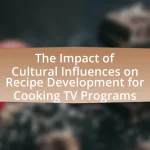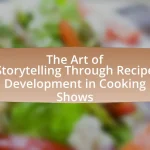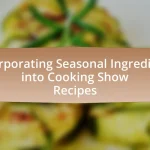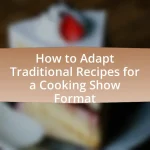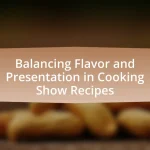The article focuses on the essential process of testing and refining recipes prior to filming a cooking show. It outlines the key steps involved, including recipe creation, testing, and adjustments based on taste tester feedback, ensuring accuracy and flavor. The article also discusses criteria for selecting recipes, the influence of audience preferences, and the importance of timing and visual presentation in recipe refinement. Additionally, it highlights best practices for finalizing recipes, common pitfalls to avoid, and practical tips to enhance the recipe testing experience, ultimately aiming to improve viewer engagement and satisfaction.
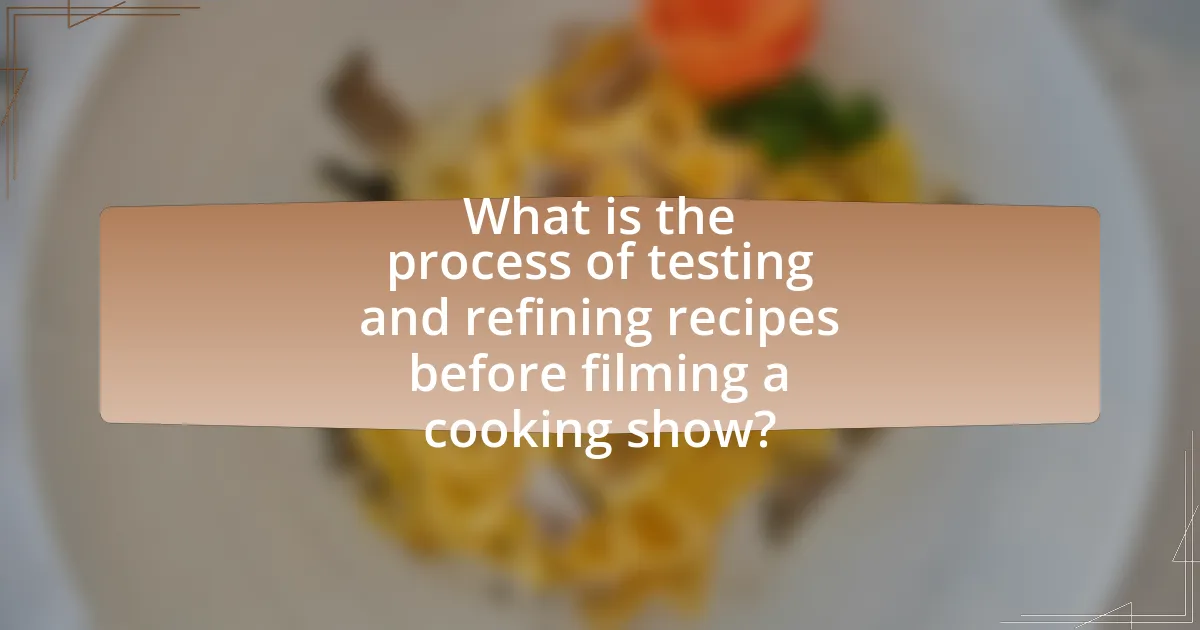
What is the process of testing and refining recipes before filming a cooking show?
The process of testing and refining recipes before filming a cooking show involves several key steps. Initially, chefs or recipe developers create a draft version of the recipe, which is then tested multiple times to ensure accuracy and flavor. During these tests, adjustments are made to ingredients, cooking times, and techniques based on the outcomes observed. Feedback from taste testers is also gathered to refine the recipe further, ensuring it meets the desired standards for presentation and taste. This iterative process is crucial, as it helps identify any potential issues that could arise during filming, such as timing or ingredient availability, ultimately leading to a polished final recipe ready for the audience.
How do you determine which recipes to test?
To determine which recipes to test, culinary professionals analyze audience preferences, seasonal ingredients, and trending cuisines. This approach ensures that the selected recipes resonate with viewers and utilize fresh, available produce, enhancing the overall appeal and quality of the cooking show. For instance, data from food trend reports indicate that recipes featuring plant-based ingredients have gained popularity, guiding the selection process toward more relevant and timely options.
What criteria should be used to select recipes for testing?
The criteria for selecting recipes for testing include clarity of instructions, ingredient availability, and audience appeal. Clear instructions ensure that the recipe can be easily followed, reducing the likelihood of errors during filming. Ingredient availability is crucial, as recipes should utilize items that are accessible to the target audience, enhancing relatability. Audience appeal is essential to engage viewers; recipes should reflect current trends or preferences to maintain interest. These criteria are supported by industry practices, where successful cooking shows often prioritize recipes that resonate with their viewers and can be executed without specialized ingredients.
How can audience preferences influence recipe selection?
Audience preferences significantly influence recipe selection by guiding content creators to choose dishes that resonate with their target demographic. For instance, if a cooking show’s audience predominantly favors vegetarian cuisine, the selection of recipes will lean towards plant-based options to enhance viewer engagement and satisfaction. Research indicates that understanding audience demographics, such as age, dietary restrictions, and cultural backgrounds, can lead to more tailored recipe choices, ultimately increasing viewership and interaction. This alignment with audience tastes not only boosts the show’s relevance but also fosters a loyal following, as viewers are more likely to return for content that reflects their culinary interests.
What are the key steps in testing a recipe?
The key steps in testing a recipe include gathering ingredients, following the recipe precisely, evaluating the results, and making necessary adjustments. First, ensure all ingredients are measured accurately and prepared as specified. Next, cook the dish according to the instructions, paying attention to timing and techniques. After cooking, assess the flavor, texture, and appearance of the dish to determine if it meets expectations. Finally, based on this evaluation, modify the recipe as needed, which may involve adjusting ingredient quantities, cooking times, or methods to enhance the final outcome. This systematic approach ensures that the recipe is reliable and produces consistent results.
How do you prepare for the recipe testing process?
To prepare for the recipe testing process, gather all necessary ingredients and equipment before starting. This ensures that you have everything on hand to execute the recipe accurately. Additionally, create a detailed plan that outlines each step of the recipe, including timing and techniques, to streamline the testing process. Having a clear structure helps identify any potential issues early on. Furthermore, consider conducting multiple test runs to refine flavors and techniques, as this iterative approach allows for adjustments based on taste and texture. This method is supported by culinary professionals who emphasize the importance of repetition in achieving consistent results.
What tools and ingredients are essential for effective testing?
Essential tools for effective testing include measuring cups, spoons, a kitchen scale, mixing bowls, and cooking utensils. These tools ensure accurate measurements and proper mixing, which are critical for recipe consistency. Key ingredients often consist of staple items like flour, sugar, salt, and various spices, as well as fresh produce and proteins relevant to the recipe being tested. The use of these tools and ingredients allows for precise replication of recipes, which is vital for achieving desired flavors and textures.
Why is it important to refine recipes before filming?
Refining recipes before filming is crucial to ensure consistency and quality in the final product. A well-tested recipe minimizes the risk of errors during filming, which can lead to wasted time and resources. Additionally, refining recipes allows for adjustments based on taste, texture, and presentation, enhancing the overall viewer experience. Studies show that cooking shows with well-prepared recipes engage audiences more effectively, as they are more likely to replicate the dishes at home, leading to higher viewer satisfaction and retention.
How does recipe refinement impact the final presentation?
Recipe refinement significantly enhances the final presentation by ensuring that the dish not only tastes good but also looks appealing. This process involves adjusting ingredients, cooking techniques, and plating methods, which directly influence visual aesthetics and overall appeal. For instance, a study published in the Journal of Culinary Science & Technology indicates that dishes with balanced colors and textures are perceived as more appetizing, demonstrating that refinement can lead to a more visually striking presentation.
What common issues arise during the filming of cooking shows?
Common issues that arise during the filming of cooking shows include timing challenges, equipment malfunctions, and ingredient availability. Timing challenges often occur due to the need to complete recipes within a set timeframe, which can lead to rushed cooking and mistakes. Equipment malfunctions, such as broken ovens or malfunctioning cameras, can disrupt the filming process and affect the quality of the show. Additionally, ingredient availability can pose a problem, as certain items may not be accessible or may require last-minute substitutions, impacting the authenticity of the recipes being showcased. These issues can hinder the overall production quality and viewer experience.
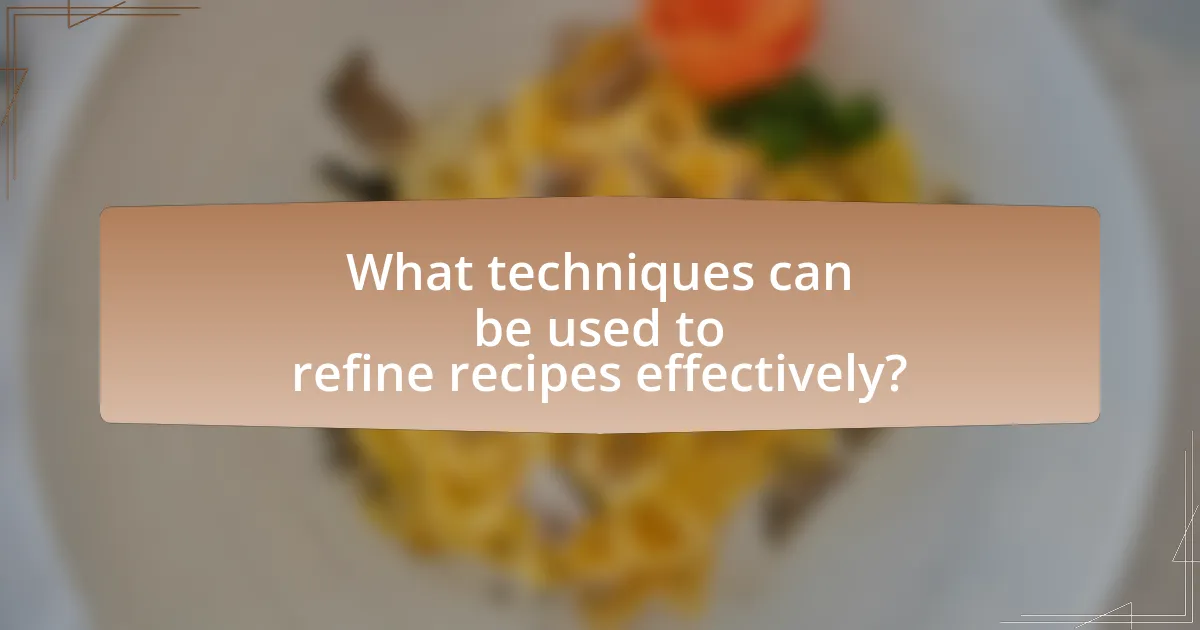
What techniques can be used to refine recipes effectively?
To refine recipes effectively, techniques such as systematic testing, ingredient substitution, and sensory evaluation can be employed. Systematic testing involves preparing the recipe multiple times while making incremental adjustments to ingredients or cooking methods, allowing for precise identification of optimal flavors and textures. Ingredient substitution focuses on replacing certain components with alternatives to enhance taste or accommodate dietary restrictions, which can lead to improved overall satisfaction. Sensory evaluation, which includes gathering feedback from taste testers, helps in assessing the recipe’s appeal and making necessary modifications based on collective preferences. These methods are supported by culinary practices that emphasize iterative improvement and consumer feedback, ensuring that the final recipe is both enjoyable and well-balanced.
How can taste testing improve recipe quality?
Taste testing can significantly improve recipe quality by providing direct feedback on flavor, texture, and overall appeal. This process allows chefs to identify specific areas for enhancement, such as adjusting seasoning levels or modifying cooking techniques. Research indicates that sensory evaluation, including taste testing, leads to more refined culinary outcomes, as it incorporates diverse palates and preferences, ensuring the final dish resonates with a broader audience. For instance, a study published in the Journal of Culinary Science & Technology highlights that recipes subjected to multiple rounds of taste testing resulted in higher satisfaction ratings among participants, demonstrating the effectiveness of this method in achieving superior recipe quality.
What methods can be employed for gathering feedback on recipes?
Methods for gathering feedback on recipes include conducting taste tests, utilizing surveys, and engaging with online cooking communities. Taste tests involve inviting individuals to sample the dish and provide immediate reactions, which can yield qualitative insights into flavor, texture, and presentation. Surveys can be distributed to a broader audience, allowing for quantitative data collection on specific aspects of the recipe, such as ease of preparation and overall satisfaction. Engaging with online cooking communities, such as forums or social media groups, enables recipe creators to receive diverse opinions and suggestions from experienced cooks and food enthusiasts. These methods collectively enhance the recipe development process by incorporating varied perspectives and preferences.
How do you incorporate feedback into recipe adjustments?
Incorporating feedback into recipe adjustments involves systematically gathering input from taste testers and making targeted modifications based on their suggestions. This process typically includes conducting taste tests with a diverse group of individuals to obtain a range of opinions on flavor, texture, and presentation. After collecting feedback, specific adjustments are made, such as altering ingredient quantities, changing cooking times, or modifying techniques to enhance the overall quality of the dish. For instance, if multiple testers indicate that a dish is too salty, the recipe can be adjusted by reducing the salt content. This method ensures that the final recipe aligns with the preferences of the intended audience, ultimately improving the dish’s appeal and success in a cooking show context.
What role does timing play in recipe refinement?
Timing is crucial in recipe refinement as it directly influences the cooking process and the final outcome of the dish. Precise timing ensures that ingredients are cooked to the right texture and flavor, which is essential for achieving the desired quality in a recipe. For instance, overcooking vegetables can lead to loss of nutrients and undesirable textures, while undercooking proteins can result in food safety issues. Studies have shown that specific cooking times can enhance flavor development, such as the Maillard reaction in meats, which occurs optimally at certain temperatures and durations. Therefore, understanding and controlling timing is fundamental for creating consistent and high-quality recipes suitable for a cooking show.
How can you ensure that cooking times are accurate?
To ensure that cooking times are accurate, use a reliable kitchen timer and follow standardized recipes. Standardized recipes provide specific cooking times based on tested methods, which helps maintain consistency. Additionally, using a thermometer to check internal temperatures can confirm doneness, as cooking times may vary based on equipment and ingredient variations. Research indicates that precise timing and temperature control significantly affect the quality of the final dish, reinforcing the importance of these practices in achieving accurate cooking times.
What strategies help in managing preparation and cooking times?
To manage preparation and cooking times effectively, one strategy is to create a detailed timeline that outlines each step of the cooking process. This timeline should include specific time allocations for preparation tasks, such as chopping vegetables or marinating proteins, and cooking times for each dish. Research indicates that professional chefs often use mise en place, which involves organizing ingredients and tools before starting to cook, to streamline their workflow and reduce cooking times. By having everything prepped and ready, chefs can minimize delays and ensure a smoother cooking experience.
How can visual presentation be enhanced during recipe testing?
Visual presentation during recipe testing can be enhanced by utilizing proper plating techniques, color contrast, and garnishing. Effective plating involves arranging food in a visually appealing manner, which can significantly impact the viewer’s perception of the dish. Research indicates that dishes with vibrant colors and contrasting elements are more likely to attract attention and stimulate appetite, as supported by studies in food aesthetics. Additionally, incorporating fresh herbs or edible flowers as garnishes can elevate the visual appeal, making the dish look more sophisticated and inviting.
What plating techniques can elevate the dish’s appeal?
Plating techniques that can elevate a dish’s appeal include the use of negative space, height variation, and color contrast. Negative space involves leaving empty areas on the plate to draw attention to the food, enhancing visual interest. Height variation can be achieved by stacking ingredients or using molds, creating a dynamic presentation that captures the eye. Color contrast, achieved by pairing vibrant ingredients with neutral backgrounds, makes the dish more visually striking. Research indicates that visually appealing presentations can increase perceived taste and enjoyment, as supported by studies in food aesthetics and consumer behavior.
How does color and texture influence viewer perception?
Color and texture significantly influence viewer perception by affecting emotional responses and perceived quality of visual content. Research indicates that colors can evoke specific feelings; for example, warm colors like red and orange can create a sense of excitement, while cool colors like blue and green can induce calmness. Additionally, texture adds depth and realism, enhancing the viewer’s engagement and interest. A study published in the journal “Food Quality and Preference” by Spence et al. (2016) found that food presentation, including color and texture, directly impacts taste perception and overall enjoyment. Thus, in the context of cooking shows, the strategic use of color and texture can enhance viewer attraction and satisfaction with the presented recipes.
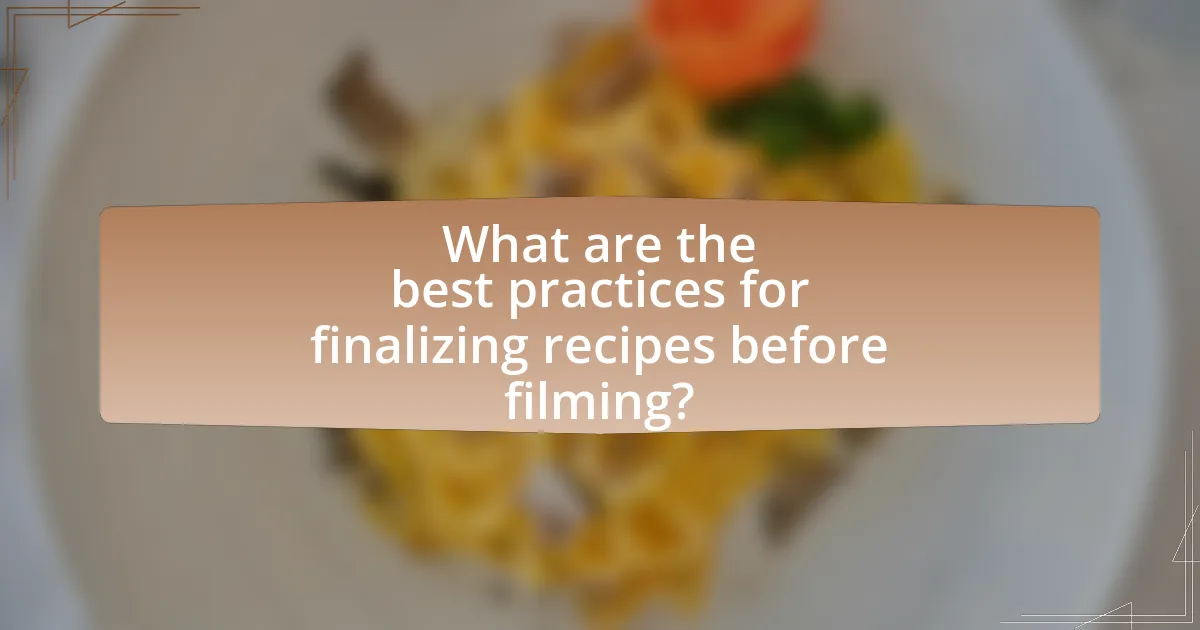
What are the best practices for finalizing recipes before filming?
The best practices for finalizing recipes before filming include thorough testing, precise measurements, and clear instructions. Thorough testing ensures that the recipe is reliable and produces consistent results, which is crucial for audience satisfaction. Precise measurements are essential to maintain accuracy and replicability, as even small variations can affect the final dish. Clear instructions help both the host and viewers understand the cooking process, making it easier to follow along. Additionally, documenting any adjustments made during testing can provide valuable insights for future episodes, ensuring continuous improvement in recipe development.
How do you create a recipe card for filming?
To create a recipe card for filming, start by clearly listing the recipe title, ingredients, and step-by-step instructions. Each ingredient should include precise measurements and any necessary preparation details, while the instructions should be concise and sequential to facilitate easy following during filming. Additionally, consider including cooking times, serving sizes, and any relevant tips or variations to enhance clarity and usability. This structured format ensures that the recipe card serves as an effective guide for both the chef and the audience, promoting a smooth filming process.
What essential information should be included in a recipe card?
A recipe card should include the recipe title, ingredient list with precise measurements, step-by-step instructions, cooking time, serving size, and any necessary equipment. The title identifies the dish, while the ingredient list ensures accurate preparation. Step-by-step instructions guide the cooking process, and cooking time indicates how long the dish will take to prepare. Serving size informs how many portions the recipe yields, and equipment details help in gathering necessary tools. This structured information is essential for clarity and successful execution of the recipe.
How can recipe cards aid in the filming process?
Recipe cards can significantly aid in the filming process by providing a structured and clear outline of ingredients and steps needed for each dish. This organization helps the production team ensure that all necessary components are prepared and available during filming, reducing the risk of missing items or steps. Additionally, recipe cards serve as a reference for the host and crew, allowing for smoother transitions and better pacing during the shoot. By having a detailed recipe card, the filming process can maintain consistency and accuracy, which is crucial for viewer satisfaction and recipe replication.
What common pitfalls should be avoided during recipe testing?
Common pitfalls to avoid during recipe testing include neglecting ingredient measurements, failing to document changes, and not considering audience preferences. Neglecting precise measurements can lead to inconsistent results, as studies show that accuracy in ingredient ratios is crucial for replicating successful dishes. Failing to document modifications prevents the ability to replicate or improve recipes, which is essential for refining culinary techniques. Additionally, not considering audience preferences can result in dishes that do not resonate with viewers, as market research indicates that understanding target demographics significantly influences recipe success in cooking shows.
How can overcomplicating recipes affect the filming process?
Overcomplicating recipes can significantly hinder the filming process by increasing preparation time and creating potential for errors. When recipes are overly complex, they require more ingredients, steps, and techniques, which can lead to confusion for both the chef and the crew. This complexity can result in longer shooting schedules, as each step may need to be repeated or adjusted, causing delays. Additionally, intricate recipes can overwhelm viewers, making it difficult for them to follow along, which diminishes the educational value of the show. Studies in production efficiency indicate that simpler recipes can enhance viewer engagement and streamline filming, as they allow for smoother transitions and clearer instructions.
What are the risks of not testing recipes thoroughly?
Not testing recipes thoroughly poses significant risks, including inconsistent results, food safety issues, and negative viewer experiences. Inconsistent results can lead to variations in taste, texture, and appearance, which may disappoint viewers expecting a specific outcome. Food safety issues arise when ingredients are improperly combined or cooked, potentially leading to foodborne illnesses. Additionally, negative viewer experiences can result from poorly executed recipes, damaging the credibility of the cooking show and reducing audience trust. These risks highlight the importance of thorough testing to ensure reliable and safe culinary outcomes.
What practical tips can enhance the recipe testing experience?
To enhance the recipe testing experience, it is essential to maintain a detailed recipe journal that tracks ingredients, measurements, and cooking times. This practice allows for precise adjustments and improvements based on previous tests. Additionally, conducting blind taste tests with a diverse group of tasters can provide unbiased feedback, ensuring that the recipe appeals to a wider audience. Research indicates that involving multiple testers can lead to a more refined final product, as varied palates contribute to a comprehensive evaluation of flavors and textures. Furthermore, utilizing high-quality ingredients consistently can significantly impact the outcome, as the quality of components directly influences the dish’s overall taste and presentation.
How can you streamline the testing process for efficiency?
To streamline the testing process for efficiency, implement a structured testing framework that includes standardized recipes, clear objectives, and a feedback loop. This approach allows for consistent results and quicker iterations. For instance, using a checklist for each recipe can help ensure all necessary steps are followed, reducing the likelihood of errors and saving time. Additionally, gathering feedback from a small group of testers can provide valuable insights quickly, enabling faster adjustments to recipes. Research indicates that structured testing can reduce the time spent on revisions by up to 30%, enhancing overall productivity in recipe development.
What resources are available for aspiring cooking show hosts?
Aspiring cooking show hosts can access various resources, including online courses, workshops, and mentorship programs focused on culinary skills and presentation techniques. For instance, platforms like MasterClass offer courses taught by renowned chefs, while local culinary schools provide hands-on training. Additionally, networking opportunities through food industry events and social media groups can connect aspiring hosts with experienced professionals for guidance and feedback. These resources are essential for developing the necessary skills and knowledge to succeed in hosting a cooking show.


